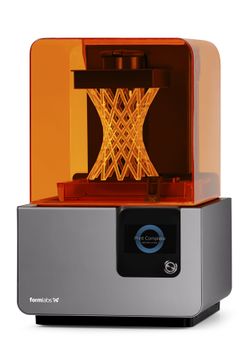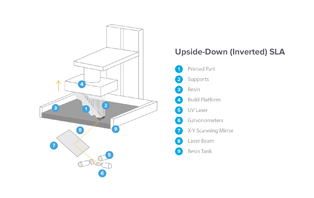Difference between revisions of "Formlabs 3D Printer"
| Line 33: | Line 33: | ||
=== Why Pick the Form 2? === | === Why Pick the Form 2? === | ||
| − | The Form 2 is most useful for its ability to print incredibly accurate parts, with layers as thin as .025mm thick, depending on the resin selected. Due to the size of the Form 2, it can only be used to print smaller pieces, and the extra detail also causes the Form 2 to generally be the slowest printer in the lab. Unless an exception is made, a model with supports included should be no larger than 30mL worth of resin. If specific material properties are needed for a print, the Form 2 is a good option to look into thanks to the many differing resins available for use. | + | The Form 2 is most useful for its ability to print incredibly accurate parts, with layers as thin as .025mm thick, depending on the resin selected. Due to the size of the Form 2, it can only be used to print smaller pieces, and the extra layering for detail combined with the de-lamination process also causes the Form 2 to generally be the slowest printer in the lab. Unless an exception is made, a model with supports included should be no larger than 30mL worth of resin. If specific material properties are needed for a print, the Form 2 is a good option to look into thanks to the many differing resins available for use. |
=== Choosing a Resin Type === | === Choosing a Resin Type === | ||
| Line 85: | Line 85: | ||
==Resources== | ==Resources== | ||
[[Form Wash and Cure]] | [[Form Wash and Cure]] | ||
| − | + | [[Prototype Lab#SLA Printing Anchor|SLA Printing]] | |
Link to shop [[Equipment]] page<br \> | Link to shop [[Equipment]] page<br \> | ||
Revision as of 15:37, 5 November 2018
The Form 2 is Formlab's 3rd generation printer boasting a whole range of new features including a new peeling mechanism, heated tank, touchscreen display, wireless controls and an automated resin system. The resulting prints that come off of the Form 2 have consistently been among the highest quality objects to come off of any desktop 3D printer. This machine is best used with the Form Wash and Cure [1]
Documentation
Training
SLA Printing
- The Form 2 employs SLA Printing.
Why Pick the Form 2?
The Form 2 is most useful for its ability to print incredibly accurate parts, with layers as thin as .025mm thick, depending on the resin selected. Due to the size of the Form 2, it can only be used to print smaller pieces, and the extra layering for detail combined with the de-lamination process also causes the Form 2 to generally be the slowest printer in the lab. Unless an exception is made, a model with supports included should be no larger than 30mL worth of resin. If specific material properties are needed for a print, the Form 2 is a good option to look into thanks to the many differing resins available for use.
Choosing a Resin Type
Currently the lab supports printing with:
- Black/grey/clear standard: the Standard Resins section of Choosing the Right Material
- Tough: Tough
- Durable: Durable
- Flexible: Flexible
See the respective links for each resin for an in-depth descriptions of each resin's properties and suggested applications, or look at Choosing the Right Material for a shorter overview.
Changing Resin
- Remove, clean, and replace the build plate.
- Pull lever holding build plate in place up, allowing the build plate to be removed.
- Place the build plate on the holding rack in the Form Wash. Run the build plate through the Wash to remove resin. For the build plate, the Wash should be set to 10 minutes.
- Let the build plate air dry before replacing, secure by flipping lever down.
- Remove and replace resin tank and wiper.
- Firmly pull wiper back until it's out of its slot and loose in the resin tank. Leave the wiper in the resin tank, each tank has its own wiper.
- Firmly pull tank back until it pops loose of the printer, put the appropriate lid on the resin tank, and store with wiper in tank.
- Before inserting the new resin tank, remove its lid and store.
- Slot the new resin tank into place in the printer.
- Use a scraping tool to dredge bottom of new resin tank for any hardened resin or loose bits of material, remove any found bits.
- Slot the new tank's wiper into place.
- Be sure to clean up any resin that spills during this process.
- Remove and replace the resin cartridge in the back of the printer.
- Close the lid of the cartridge if it's open.
- Pull cartridge out of the printer.
- Wipe dry the resin drip on the bottom of the cartridge, then store.
- Insert new resin cartridge, of the same resin as the tank.
- Open lid on resin cartridge before starting a print, and close after.
Removing Prints
- Finished prints
- Use a scraping tool to remove the print and any extra material from the build plate, taking care to not scratch the build plate. Go as carefully and as slowly as needed to prevent damaging the print.
- The build plate stand can be used for easier removal.
- Wash the print in the Form Wash.
- If the print is being cured, only remove support material after it has been run through the Form Cure.
- Supports should be clipped off, and any leftover support material can be sanded down if desired.
- Use a scraping tool to remove the print and any extra material from the build plate, taking care to not scratch the build plate. Go as carefully and as slowly as needed to prevent damaging the print.
- Failed prints
- Follow the same process for finished prints for removing.
- When a print fails, the build plate must be cleaned and run through the Wash before a new print can be started, as leftover residue from the failed print can cause subsequent prints to also fail. That's bad.
Washing and Curing Prints
See the Form Wash and Cure page.
Common Errors
Maintenance
- Every few prints the resin tank should be dredged with a scraping tool to search for any hardened resin or loose bits of material, and when resin tanks are switched out. Remove any found bits.
Resources
Form Wash and Cure
SLA Printing
Link to shop Equipment page
Common errors, how to fix
More in depth to resin changing
Why choose form printer/ why choose resin type
Pictures-saved in Form 2 Wiki Pics

